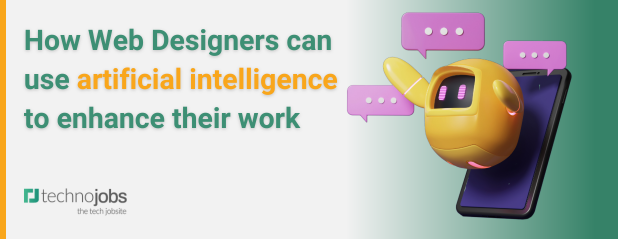How Web Designers can use artificial intelligence to level up their career

Over the past few years, the role of a Web Designer has developed from creating static layouts to dynamic and personalised user experiences. As artificial intelligence (AI) continues to reshape industries, it has emerged as a valuable tool in the world of web design. AI has the potential to revolutionise the way websites are created and experienced, offering designers powerful tools to create more engaging, efficient, and innovative digital designs.
In this article, we will share how Web Designers can use AI to level up their career, and what skills you need to learn to begin using AI. By using AI to its full capacity, Web Designers can push the limits of web design, in addition to improving their own skill sets.
Personalised user experiences
AI algorithms can analyse user data to understand individual preferences and behaviours. Designers can use this information to create personalised content and interfaces that resonate with users, leading to higher engagement and customer satisfaction.
Dynamic content generation
AI-powered tools can create dynamic content, such as personalised recommendations, product descriptions, or blog posts. This saves time and ensures that the website's content remains fresh and relevant.
Automated design tasks
AI can automate repetitive design tasks, such as resizing images, optimising layouts for different devices, and even generating design prototypes. This allows designers to focus on the more creative aspects of their work.
Chatbots and virtual assistants
Integrating AI-driven chatbots or virtual assistants can enhance user interactions. These tools can provide instant customer support, answer frequently asked questions, and guide users through the website.
Image and video enhancement
AI-powered tools can enhance images and videos, improving visual quality and optimising load times. This ensures that multimedia elements on the website create a visually appealing and seamless experience.
AI skills to learn for image and video enhancement:
Computer vision - understand computer vision concepts, such as image classification, object detection, and image segmentation. This can help you integrate AI-powered image and video processing into your designs.
Predictive analytics
AI can predict user behaviours, such as which products a user might be interested in or when they're likely to make a purchase. Designers can use these insights to optimise layouts and calls-to-action.
A/B testing and optimisation
AI algorithms can automate A/B testing, comparing different design variations to identify the most effective ones. This data-driven approach improves conversion rates and user engagement.
Voice user interfaces
With the rise of voice assistants, designers can incorporate AI-driven voice user interfaces (VUIs) into websites. This enables users to navigate and interact with the site using voice commands.
Accessibility features
AI can assist in making websites more accessible. Text-to-speech capabilities, automatic closed captioning, and screen readers can enhance usability for people with disabilities.
AI skill to learn for accessibility features:
API Integration - Learn how to integrate AI services through APIs, this can enable you to incorporate features like speech recognition, image recognition, and language translation into your web designs.
Data visualisation
AI can help designers create interactive and insightful data visualisations that convey complex information in a user-friendly manner.
AI skills to learn for data visualisation:
Data visualisation and analysis - learn about data visualisation libraries like Matplotlib and Seaborn, which can aid in visually representing AI-generated insights and analysis to clients and stakeholders.
Content curation
AI algorithms can curate relevant content from various sources, making it easier for designers to gather resources and inspiration for their projects.
Real-time analytics
AI-powered analytics tools provide designers with real-time insights into user behaviours, helping them make informed design decisions and repeat based on actual user interactions.
AI skill to learn for analytics:
Data pre-processing - learn how to clean, pre-process, and transform data, which involves techniques like data normalization, feature scaling, and handling missing data.
Design inspiration
AI can analyse design trends and user preferences to offer designers inspiration and suggestions for design elements, layouts, and colour schemes.
Ethical AI design
Designers with AI skills can ensure that AI-powered features are ethically designed, avoiding biases, and considering user privacy and data security.
As well as some of the skills listed above, these are some of the basic AI skills you should learn to help elevate your career as a Web Designer:
- Understanding basic programming languages, such as Python. Python is widely used in AI development due to its simplicity and extensive libraries for machine learning and data analysis.
- Understanding machine learning basics, including different algorithms, model training, and evaluation techniques, will provide a strong foundation.
- Understanding neural networks and deep learning, including neural network architecture, activation functions, and optimisation algorithms, can enable you to build and train sophisticated AI models for various tasks.
- Understanding AI frameworks and libraries, including TensorFlow, PyTorch, or Keras. These libraries provide pre-built tools and functions to streamline the development of AI models.
- Natural Language Processing (NLP) techniques such as tokenisation, text classification, sentiment analysis, and named entity recognition can empower you to create websites with text analysis capabilities.
- Version Control (e.g., Git), which is crucial for collaboration and managing changes in code. Git is a widely used tool for tracking code changes and working collaboratively with others.
By integrating AI into your workflow, Web Designers can create more engaging, efficient, and user-centric websites that stand out in today's competitive digital landscape. The key is to embrace AI as a tool that enhances creativity and problem-solving rather than replacing the designer's role.
Remember, you don't need to become an AI expert overnight. Start by building a foundation in AI concepts and gradually integrate AI techniques into your design process as you become more comfortable with the technology.




